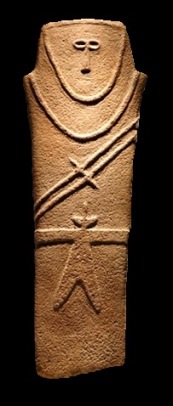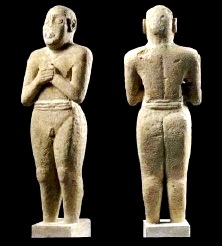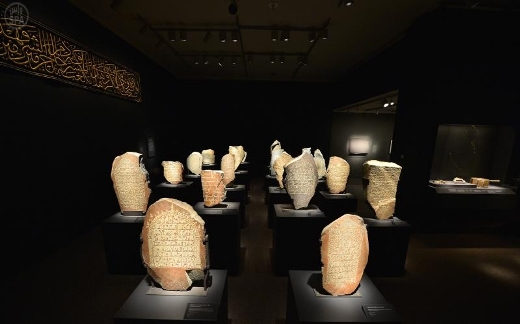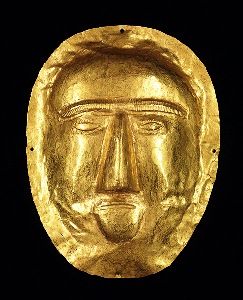
With 320 objects spanning more than one-million years, from Paleolithic petroglyphs to the rise of the modern Saudi state, the exhibit is a showcase of treasures never seen in the United States until now.
The exhibit is laid out chronologically and begins with three rock stelae with individual faces carved on them recovered from Found near Ha’il in the north-central region of Saudi Arabia. They date to around 3500 BCE, and starkly lit, the stele glow against a black background, and invite you to approach and ponder the people who made them. Other early objects are those from Tarut, an island on Saudi Arabia’s eastern coast that was the center of the Dilmun civilization that was later to move to the island now known as Bahrain. Objects from this era include black, gray and white stone jars, cups, and bowls that may have originated in SE Iran or may have been made on Tarut. Items of similar design and manufacture have been found in Syria, Mesopotamia, and as far east as the Fergana Valley in present-day Uzbekistan, indicating the extent of the trade network that the people of Tarut were part of in antiquity.

Although I preferred the earlier items on display because of the evidence they provided of connections with other ancient cultures, there are some stunning things to see in the later part of the exhibit as well. One such item is a gold funerary mask from the tomb of a young girl from Thaj that is around 2000 years old. The mask is serene and beautiful and reminds me of the “Mask of Agamemnon” found at Troy that dates to 1500 BCE. Also in the tomb was a large amount of gold jewelry with semiprecious stones such as amethysts, carnelian and pearls that would have adorned the girl in the afterlife. The design of the mask and the jewelry both show contact with Greco-Roman civilization.
Incense and other trade items flowed along these ancient mercantile rivers for the past five- or six-thousand years and influenced the cultures participating in the trade.

The exhibit runs through February 24th in Washington and then travels to the Houston Museum of Fine Arts, San Francisco’s Asian Art Museum and venues in Chicago and Boston through early 2015. If you are near any of these venues or will be passing through, make time to see this exhibit. You will learn a lot and see many, “wondrous things.” (Words by Laura Kelley. Photo of Ha’il Stelae from exhibition website; photo of Singing Man from Tarut from pamphlet, Tarut Island by Murtadha Al-Ruwaie)

